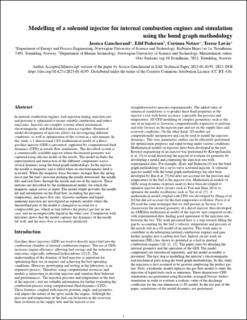| dc.description.abstract | In internal combustion engines, fuel injection timing, injection rate and pressure is optimized to ensure suitable combustion and reduce emissions. Injectors are complex systems where mechanical, electromagnetic, and fluid dynamics interact together. Numerical model development of injectors allows for investigating different conditions, as well as optimization of the system in a safe manner. In this study, a 1-dimensional (1D) mathematical model of a direct gasoline injector (GDI) is presented, supported by computational fluid dynamics (CFD) in-nozzle flow simulations. The described system is a commercially available injector where the internal geometry was captured using silicone molds of the nozzle. The model includes the representation and interaction of the different components across several domains using the bond graph methodology. In the injector, the needle is magnetic and is lifted when an electromagnetic field is activated. When the magnetic force becomes stronger than the spring force and the fuel’s pressure pushing the needle downward, the needle lifts and fuel flows through the nozzle and out of the injector. These motions are described by the mathematical model, for which the magnetic signal serves as input. The model output provides the needle lift and information on the fluid flow, including the pressure, temperature, and mass flow rate. Gaseous methane and liquid ammonia injection are investigated in separate models where the thermofluid part of the model is changed to account for a compressible gas, which in turn follows the perfect gas law in one case, and an incompressible liquid in the other case. Comparison with literature shows that the model captures the dynamics of the needle lift well, and the mass flow is accurately predicted. | en_US |

